ClaimStat 2.0: Reducing Claims and Protecting New Yorkers
Executive Summary
In early 1994, New York Police Department (NYPD) Commissioner Bill Bratton and Deputy Commissioner Jack Maple debuted CompStat, a groundbreaking tool allowing the agency to identify and combat crime trends. Along with the dedicated service of the men and women of the NYPD, CompStat is widely credited with helping to drive down crime rates from record highs in the 1990s to today’s historic lows by introducing a new level of accountability, and by providing police chiefs with a new set of performance metrics by which to judge their crime-fighting efforts.
Inspired by the success of CompStat, in 2014 Comptroller Scott M. Stringer launched ClaimStat, a data-driven approach to claims management that drills down on the thousands of legal claims filed against the City every year to identify patterns and practices that lead to lawsuits. By identifying legal “hot spots,” ClaimStat provides a roadmap for City agencies to address practices or deficiencies that generate costly or preventable lawsuits against the City. Like CompStat, ClaimStat seeks to give City agency heads both the tools and information they need to reduce claims, and a methodology to measure their success.
Today, with the formalization of several agreements between the Comptroller’s Office and different City agencies, ClaimStat has entered a new phase — ClaimStat 2.0 — that entails working collaboratively to provide real-time information through dedicated portals to agency heads and using new data analytics tools to target claims trends.
Since the inception of ClaimStat, the Comptroller’s Office has proactively expanded the initiative. In 2016, the Comptroller’s Office provided claims data to the New York City Department of Environmental Protection (DEP) to help the agency design future sewer systems with additional capacity to meet the expected effects of climate change. More recently, in 2017, the Comptroller entered into an operating agreement with the New York City Department of Sanitation (DSNY) to provide real-time claims data to DSNY for internal risk analysis. Through ClaimStat, the Comptroller’s Office will produce location specific data that can help DSNY drivers avoid costly accidents. DSNY is exploring how data can be used to identify areas with a high frequency of accidents to explore if street design, additional driver training, or vehicle improvements can drive the number of claims down. Further collaborations with the Department of Citywide Administrative Services and the Department of Transportation help minimize the cost of settlements and judgements stemming from accidents on the City’s roadways.
The Comptroller’s Office will continue working collaboratively with City agencies to identify claim trends, help reform policy and procedures that drive claims activity, and to secure evidence that aids the Comptroller’s Office decisions to resolve viable or reject frivolous claims far earlier in the process.
The longest running ClaimStat partnership — between the Comptroller’s Office and the NYPD — is yielding tangible results. In 2014 the Comptroller’s Office and the NYPD began sharing information and expertise to target claims activity within the City. Key results include the following:
- Since the start of the data-sharing agreement between the NYPD and the Comptroller’s Office, claims against the department have fallen 20.3 percent from FYs 2014 to 2016.
- Between FY 2015 and FY 2016, personal injury claims filed against the NYPD dropped by 10.2 percent. Likewise, between FY 2014 and FY 2015, personal injury claims against the agency dropped 11.3 percent.
- This downward pattern effectively reversed an eight year trend of rising claims filed per year against the NYPD.
- Today’s decline in claims activity is filtering down to local precincts and neighborhoods. During calendar year 2016, personal injury claims per 100 crime complaints have fallen in 65 percent of the City’s police precincts.
However, despite the encouraging decline in the number of claims filed against the NYPD in FY 2016, the total cost of NYPD claim settlements rose to $279.7 million, an increase of 24 percent over FY 2015 and a record high for NYPD settlements. The discrepancy between the declining volume of NYPD claims and the rising cost of settlements is partially attributable to the settlement of a number of claims addressing incidents that occurred as far back as the early 1980s and the 1990s, as will be discussed later in this report.
The rising cost in claims highlights the urgent need to reduce the City’s exposure to costly settlements and judgments that comprise a growing proportion of the City’s budget. By continuing to provide real-time data to the NYPD and other City agencies, ClaimStat can help reduce the number of claims filed, and consequently, stem rising settlement costs, and save taxpayer dollars that can be better spent on New York City’s schools, parks, or libraries.
ClaimStat and the NYPD
In 2014, the Comptroller’s Office and the NYPD entered into a first-of-its-kind agreement to share claims information in real time. Recognizing the power of using real-time data to inform law enforcement decisions and drive accountability, the NYPD and the Comptroller’s Office meet regularly in a joint working group to analyze claims activity. Additionally the NYPD has launched a Risk Assessment Unit, charged with examining claim trends on an ongoing basis.
With the advent of the data-sharing agreement, the deployment of ClaimStat data and other risk-management tools, coupled with the hard work of NYPD officers and management, the number of tort claims filed against the NYPD has declined significantly — by 20.3 percent since FY 2014.
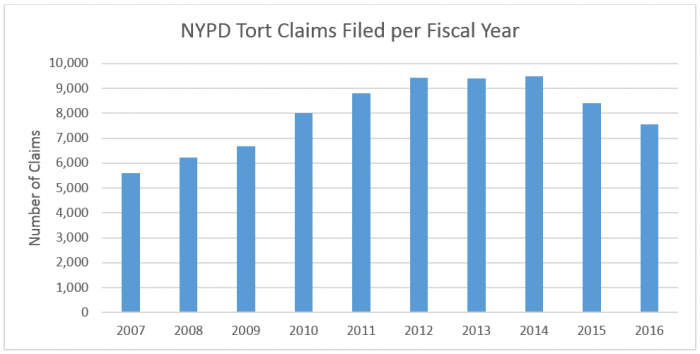
While it is difficult to attribute the decline in claims volume directly or wholly to ClaimStat, the timing is very suggestive. Starting in November 2014, ClaimStat data has given the NYPD the ability to flag potentially problematic practices, shifts, units, or officers that drive claims. Other changes to NYPD personnel, such as the addition of 8,000 new officers to the force, and NYPD policy in recent years, such as the decline in stop-and-frisk, do not produce similar patterns in claims data. As the following graphs indicate, stop-and-frisk encounters peaked in the first quarter of 2012, while the number of claims filed remained steady. Indeed, counterintuitively, the sharp drop in stop-and-frisk encounters in 2011 did not immediately and directly reduce claims volume.
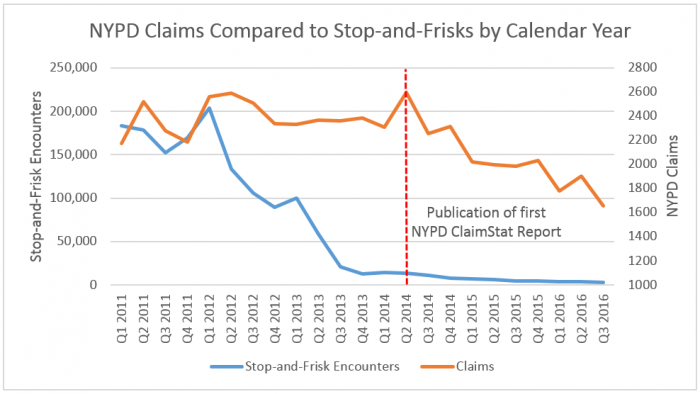
Personal Injury Claims filed against the NYPD
FY 2015 and FY 2016 also saw marked decreases in the number of police action claims that result from alleged improper police action, such as false arrest or imprisonment, excessive force or assault, or failure to provide police protection. Police action claims filed per year have decreased from 5,645 in FY 2014 to 4,473 in FY 2016, or a 20.8 percent decrease.
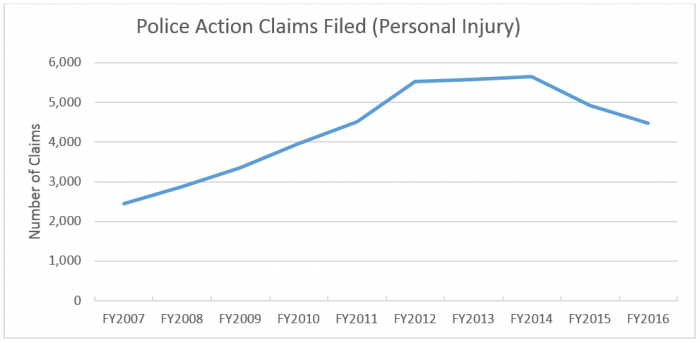
The decline in police action claims activity is spread across precincts. An analysis of police action claims by precinct, adjusted for crime, showed declines in claims filed across more than half of the City’s precincts.[ii]
In calendar year 2014, the 44th Precinct led the City in police action claims per 100 crime complaints with 17.04 claims.[iii] Located in the Southwest Bronx, the 44th Precinct recorded more than six times the number of claims as the 18th Precinct in midtown Manhattan, despite having a similar number of crime complaints per year. By the end of calendar year 2016, police claims emanating from the 44th Precinct tallied only 8.7 claims per 100 crime complaints—the largest such drop in the City during this period.
Despite significant progress, an analysis of police action claims continues to reveal significant disparities in claims activity between precincts, even after adjusting for crime rates. A concentration of police precincts in the Bronx, Northern Manhattan, and the interior of Brooklyn show a high rate of police action claims filed per 100 crime complaints for both calendar years 2015 and 2016.

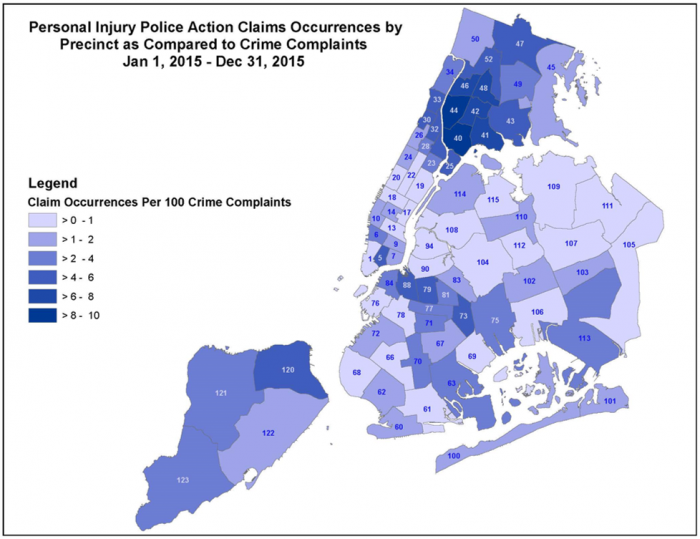
The NYPD should continue to use ClaimStat data to examine risk management practices within those precincts recording high numbers of police action claims. By reforming flawed policies or procedures that result in claims, meritorious or not, and retraining officers, the NYPD is improving its service delivery and cultivating closer community relationships.
| NYPD Precincts with the Most Claims per Crime Complaint in 2016 | ||||
| Precinct | Borough | Police Action Claims in 2016 | Crime Complaints in 2016 | Claims Per 100 Crime Complaints in 2016 |
| 41 | Bronx | 115 | 1,125 | 10.22 |
| 42 | Bronx | 129 | 1,379 | 9.35 |
| 40 | Bronx | 208 | 2,369 | 8.78 |
| 44 | Bronx | 195 | 2,230 | 8.74 |
| 46 | Bronx | 135 | 1,891 | 7.14 |
| 32 | Manhattan | 72 | 1,037 | 6.94 |
| 73 | Brooklyn | 98 | 1,568 | 6.25 |
| 48 | Bronx | 95 | 1,527 | 6.22 |
| 75 | Brooklyn | 160 | 3,226 | 4.96 |
| 25 | Manhattan | 51 | 1,040 | 4.90 |
The Comptroller’s Office will continue to provide the NYPD with ClaimStat data and will assist in efforts to reduce the number of claims filed against the NYPD. Reducing claims volume each year is the first step in curbing rising claim costs in future years.
NYPD Claims Costs
Despite the welcome decline in the number of claims filed against the NYPD in FY 2015 and FY 2016, settlement and judgment payouts resulting from NYPD claims have continued to rise each year since 2013. As the chart below reveals, settlements and judgments of claims against the NYPD reached a new high of $279.7 million in FY 2016.
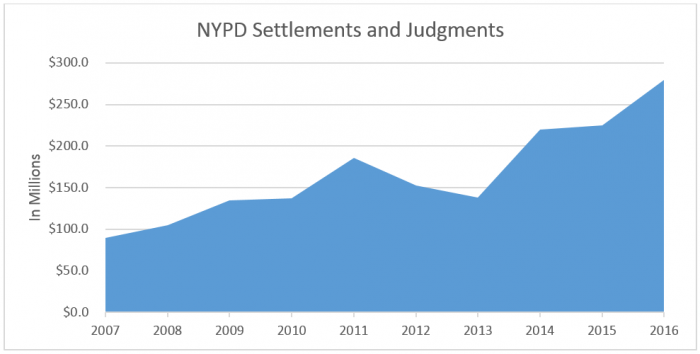
Although the number of claims filed per year has decreased since FY 2014, it is critical to note that there is no real-time correlation between claims filed and claims paid. This steady rise in settlements and judgments for NYPD claims since FY 2013 is attributable to several factors. First, with the number of claims filed against NYPD increasing every year from 2007 to 2014[iv], it is natural to expect a corresponding increase in payouts in subsequent years. Between the date a claim is filed and the date a claim is resolved, claims may take several years to litigate.
Additionally, the Comptroller’s Office has focused on limiting the City’s exposure by resolving historical claims where the incident giving rise to the claim against the NYPD took place over 10 years prior to settlement. For example, the current administration has settled many wrongful incarceration claims pre-litigation to drive down future costs of litigation and settlement.
As the below chart demonstrates, the settlement of these historical claims against the NYPD compose a significant portion of all NYPD settlements and judgments from FY 2014 to FY 2016.

In FY 2016, four groups of historical cases against the NYPD account for a substantial percentage of the $279.7 million figure. They include:
- Wrongful conviction claims resulting from the 1995 “Soundview Murders” settled for $40.0 million.
- Actions filed against the “Mafia Cops,” former NYPD Detectives Louis Eppolito and Steven Caracappa, for alleged connections to the murders that happened in the 1980s and 1990s settled for $13.5 million. (A related case involving these former Detectives settled for $5.0 million in FY 2015 and former Detective Eppolito was also sued in a wrongful conviction case that settled for $9.9 million in FY 2011.)
- The City settled Alan Newton’s wrongful conviction claim, related to a rape, assault, and robbery that occurred in 1984, for $12.1 million.
- Finally, the attorneys’ fees in the “Stop and Frisk” litigation (Floyd v. City of New York) settled for $11.3 million.
These four settlements alone accounted for $76.7 million, or 27 percent, of the $279.7 million NYPD FY 2016 payouts.
There were also multiple settlements that accounted for the $53.5 million paid out in historical NYPD claims in FY 2015, including a number of vacated murder convictions. Among those were:
- Jabbar Collins (Arrested in 1994 – settled for $10.0 million).
- Jonathan Fleming (Arrested in 1989 – settled for $6.25 million).
- The Hill Brothers (All arrested in 1987 – Robert Hill, settled for $7.2 million; Darryl Austin, settled for $3.9 million; and Alvena Jennette, settled for $6.0 million).
- Anthony Ortiz (Arrested in 1989 – settled for $4.3 million).
- Israel Vasquez, related to the “Soundview Murders” ($4.9 million).
- The wrongful death claim of the estate of Nicholas Guido, murdered as the result of mistaken identity related to the “Mafia Cops,” settled for $5.0 million.
These settlements of historical claims have contributed to the increased settlement and judgment costs experienced by the NYPD over the last three fiscal years. With time, as these historical claims are resolved and the number of new claims continues to decline, the City can hopefully see a reduction in settlements and judgments in the future.
Conclusion
In FY 2016, New York City paid out more than $1 billion in settlements and judgments resulting from claims brought against the City. In all, spending to settle tort claims currently amounts to approximately $73 per New York City resident. In FY 2016 settlements and judgments represented a spending allocation greater than the FY 2017 expense budgets for the Department of Parks and Recreation, the Department of Buildings, the Department of Consumer Affairs, and the City’s three library systems combined.[v]
Addressing claim trends is crucial to both safeguarding the City’s budget and to ensuring that City services are delivered in a safe and effective manner. On the strength of the results demonstrated by the NYPD, the Comptroller’s Office will continue to engage City agencies with the goal of driving down both claims filed and settlement costs.
Appendix
LEGAL BACKGROUND
From trip-and-falls on City property to medical malpractice in a City hospital, the Comptroller is ultimately responsible for settlement and adjustment of claims in favor of or against the City of New York. The Comptroller’s central role in the claims process is set forth in New York City Charter § 93(i). When a claim is filed against the City, the Comptroller’s Bureau of Law & Adjustment (BLA) investigates and evaluates the claim. Should a claim have merit and if the City would benefit from avoiding protracted litigation, the Comptroller can elect to negotiate a settlement prior to litigation.
If a case proceeds to litigation, the New York City Corporation Counsel is required to seek prior approval from the Comptroller’s Office for settlements of lawsuits. The Comptroller’s Office also works with Corporation Counsel to pursue claims against individuals or entities against whom the City has a claim. The Comptroller is uniquely qualified to identify potential claim trends affecting a variety of agencies.
Tort and non-tort claims are filed against the City. Tort claims stem from either allegations of personal injury or property damage caused by City parties. Personal injury claims involve allegations of bodily harm, from trip-and-falls, medical malpractice, police misconduct, civil rights violations, motor vehicle accidents, injury to specific uniform services employees (police officers, firefighters and sanitation workers), and public school-related injuries. Property damage claims involve allegations of damage caused by a City party to motor vehicles, homes, and other personal property.
Non-tort claims are disputes concerning contracts between the City and its contractors or employees, as well as claims filed by private individuals seeking refunds for alleged overpayments of various items such as taxes or fines, alternative dispute resolution claims, equitable claims, salary claims, Department of Education (DOE) tuition reimbursement claims, and sidewalk assessment claims.
Acknowledgements
Comptroller Scott M. Stringer thanks Nichols Silbersack, the lead writer of this report, and David Saltonstall, Assistant Comptroller for Policy.
Comptroller Stringer also recognizes the important contributions to this report made by: Seunghwan Kim, Assistant Comptroller for the Bureau of Law & Adjustment; Adam Karp, BLA Director of Tort Claims; Kathryn Diaz, General Counsel; Devon Puglia, Director of Communications; Tyrone Stevens, Press Secretary; and Lauren Jacobson, Special Assistant.
Endnotes
[i] Personal Injury claims involving improper NYPD action that are litigated in state courts are classified as Police Action claims. Claims involving police violation of Constitutional or federal rights are generally classified as Civil Rights claims.
[ii] Of the 4,196 claims filed in calendar year 2016, 3,347 claims were mapped to a specific precinct. Unmappable claims are either located outside New York City or did not contain sufficient information to appropriately pinpoint a location.
[iii] NYPD data is typically reported by calendar year while claims are typically sorted by fiscal year. This report reconciles the two data sets by reporting on claims per 100 crime complaints over calendar years.
[iv] Claims filed against the NYPD experienced a slight decline from FY 2012 (9,440 claims filed) to FY 2013 (9,412 claims filed) but increased in FY 2014 (9,491 claims filed).
[v] FY 2017 Adopted Budget: http://www1.nyc.gov/assets/omb/downloads/pdf/erc4-16.pdf